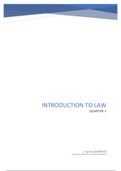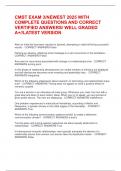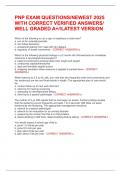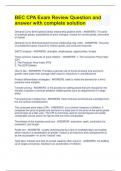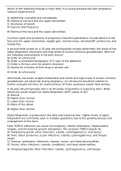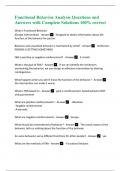INTRODUCTION TO LAW
QUARTER 1
L. Spruit (16030575)
THE HAGUE UNIVERSITY OF APPLIED SCIENCES
,Lieke Spruit (16030575) Introduction to Law Study Guide
Table of Contents
LECTURE 1.................................................................................................................................... 3
LECTURE 2.................................................................................................................................... 5
LECTURE 3.................................................................................................................................... 9
LECTURE 4.................................................................................................................................. 13
LECTURE 5.................................................................................................................................. 17
LECTURE 6.................................................................................................................................. 19
LECTURE 7.................................................................................................................................. 21
2
,Lieke Spruit (16030575) Introduction to Law Study Guide
Lecture 1
What is law?
• Definition 1: a set of universal moral principles
• Definition 2: a collection of valid rules, commands, or norms that may lack any moral
content
More definitions on the slides.
• Some definitions put a lot of emphasis on the need to have coercion, other definitions
are talking about universally shared common understanding of morality, of what is right
and what is wrong.
Legal History
Each state, civilization, tribe has its own legal history.
• Ubi societas, ibi jus (where there is a society, there is law)
• Code of Hammourabi (1760 BC)
• Solon (500 BC)
• The Twelve Tables (529-534 AC) – Justinian’s Corpus Juris Civilis
• 1804: Napoleonic Civil Code (France)
• 1900: BGB (Germany)
More history in the notes of the readings of Lecture 1
Rule of Law
As a concept of Western Legal Systems includes:
• Supremacy of law over arbitrary power
• Equality before the law
• Constitution as a consequence of the rights of individuals as defined and enforced by
the courts.
Legal systems
• Civil law: Romano-Germanic system of law (from jus commune to national law post-
1776)
• Common law: Angle-Saxon system of law
• Religious law:
o Canon Law
o Talmudic Law
o Islamic Law
Systems of law functions?
• Order and Justice
• What is order?
o Order above Justice: Hobbes and the natural state of the human being
3
,Lieke Spruit (16030575) Introduction to Law Study Guide
• What is Justice?
o Aristotle: equality, commutative and distributive justice
o Utilitarianism: Bentham and Rawls
• Law and Morality: must law be moral?
o The HLA Hart v. Fuller Debate: is immoral law valid? (p. 67 of very short intro)
o The HLA Hart v. Devlin Debate: must law protect ‘shared morality’? (p. 68 of
very short intro)
o Hart: public v. private harm
4
, Lieke Spruit (16030575) Introduction to Law Study Guide
Lecture 2
What is a source of law?
• In defining law, we identified the need to differentiate between types of norms. Many
norms tell us how to act, and not all norms belong to a legal system.
• Even if these norms contain the same obligation.
o E.g. the prohibition of murder.
▪ “You shall not kill” (one of the Ten Commandments)
▪ “Any person who intentionally and with premeditation takes the life of
another person shall be guilty of murder and shall be liable to life
imprisonment or a determinate term of imprisonment not exceeding
thirty years or a fine of the fifth category.” (Art. 289 of the Dutch Penal
Code)
o How do you make the determination what the legal obligation is of these two?
▪ Most people will recognise the legal character of the prohibition of the
Dutch Penal Code.
▪ Not on the basis of the content of the obligation: they are similar or the
same
▪ Not on the basis of the existence of a sanction: prison for the Dutch
Penal Code and burning in hell for eternity for the Commandment
▪ The key is the origin of the obligation: its source. The person or the
institution that pronounce the rule should have the authority to
pronounce it.
o Hence, in this case, the prohibition of murder is a legal obligation because it was
enacted by the Dutch legislature (“De Staten-Generaal”), who has the authority
(the power) to do so, on the basis of the Dutch Constitution (“Grondwet”). This
constitution is itself socially and politically recognised in the Netherlands as the
supreme legal norm as a matter of fact.
o This view is called legal positivism, which has been the dominant legal theory
for most of the 20th century and Anglo-American law.
Source of Law as Authority
• Authority is power
• An authoritative source of law is the basis of valid (“existing”) legal obligation
• In legal arguments, lawyers look for authority
o E.g. what is the authority for saying the people in the Netherlands have a right
to express their opinion in the media without requiring the permission of
anyone? The Dutch Constitution
• The positivist view law as a system of obligations that function as commands. Hence, a
person or an institution that claim the authority to enact legal obligations claims the
right to be obeyed.
• The “king” (or the “president”), the “prime minister”, the “parliament”, the “mayor”
have by law some defined authority. They have the right to rule, and we, as simple
citizens, have the duty to comply.
5
QUARTER 1
L. Spruit (16030575)
THE HAGUE UNIVERSITY OF APPLIED SCIENCES
,Lieke Spruit (16030575) Introduction to Law Study Guide
Table of Contents
LECTURE 1.................................................................................................................................... 3
LECTURE 2.................................................................................................................................... 5
LECTURE 3.................................................................................................................................... 9
LECTURE 4.................................................................................................................................. 13
LECTURE 5.................................................................................................................................. 17
LECTURE 6.................................................................................................................................. 19
LECTURE 7.................................................................................................................................. 21
2
,Lieke Spruit (16030575) Introduction to Law Study Guide
Lecture 1
What is law?
• Definition 1: a set of universal moral principles
• Definition 2: a collection of valid rules, commands, or norms that may lack any moral
content
More definitions on the slides.
• Some definitions put a lot of emphasis on the need to have coercion, other definitions
are talking about universally shared common understanding of morality, of what is right
and what is wrong.
Legal History
Each state, civilization, tribe has its own legal history.
• Ubi societas, ibi jus (where there is a society, there is law)
• Code of Hammourabi (1760 BC)
• Solon (500 BC)
• The Twelve Tables (529-534 AC) – Justinian’s Corpus Juris Civilis
• 1804: Napoleonic Civil Code (France)
• 1900: BGB (Germany)
More history in the notes of the readings of Lecture 1
Rule of Law
As a concept of Western Legal Systems includes:
• Supremacy of law over arbitrary power
• Equality before the law
• Constitution as a consequence of the rights of individuals as defined and enforced by
the courts.
Legal systems
• Civil law: Romano-Germanic system of law (from jus commune to national law post-
1776)
• Common law: Angle-Saxon system of law
• Religious law:
o Canon Law
o Talmudic Law
o Islamic Law
Systems of law functions?
• Order and Justice
• What is order?
o Order above Justice: Hobbes and the natural state of the human being
3
,Lieke Spruit (16030575) Introduction to Law Study Guide
• What is Justice?
o Aristotle: equality, commutative and distributive justice
o Utilitarianism: Bentham and Rawls
• Law and Morality: must law be moral?
o The HLA Hart v. Fuller Debate: is immoral law valid? (p. 67 of very short intro)
o The HLA Hart v. Devlin Debate: must law protect ‘shared morality’? (p. 68 of
very short intro)
o Hart: public v. private harm
4
, Lieke Spruit (16030575) Introduction to Law Study Guide
Lecture 2
What is a source of law?
• In defining law, we identified the need to differentiate between types of norms. Many
norms tell us how to act, and not all norms belong to a legal system.
• Even if these norms contain the same obligation.
o E.g. the prohibition of murder.
▪ “You shall not kill” (one of the Ten Commandments)
▪ “Any person who intentionally and with premeditation takes the life of
another person shall be guilty of murder and shall be liable to life
imprisonment or a determinate term of imprisonment not exceeding
thirty years or a fine of the fifth category.” (Art. 289 of the Dutch Penal
Code)
o How do you make the determination what the legal obligation is of these two?
▪ Most people will recognise the legal character of the prohibition of the
Dutch Penal Code.
▪ Not on the basis of the content of the obligation: they are similar or the
same
▪ Not on the basis of the existence of a sanction: prison for the Dutch
Penal Code and burning in hell for eternity for the Commandment
▪ The key is the origin of the obligation: its source. The person or the
institution that pronounce the rule should have the authority to
pronounce it.
o Hence, in this case, the prohibition of murder is a legal obligation because it was
enacted by the Dutch legislature (“De Staten-Generaal”), who has the authority
(the power) to do so, on the basis of the Dutch Constitution (“Grondwet”). This
constitution is itself socially and politically recognised in the Netherlands as the
supreme legal norm as a matter of fact.
o This view is called legal positivism, which has been the dominant legal theory
for most of the 20th century and Anglo-American law.
Source of Law as Authority
• Authority is power
• An authoritative source of law is the basis of valid (“existing”) legal obligation
• In legal arguments, lawyers look for authority
o E.g. what is the authority for saying the people in the Netherlands have a right
to express their opinion in the media without requiring the permission of
anyone? The Dutch Constitution
• The positivist view law as a system of obligations that function as commands. Hence, a
person or an institution that claim the authority to enact legal obligations claims the
right to be obeyed.
• The “king” (or the “president”), the “prime minister”, the “parliament”, the “mayor”
have by law some defined authority. They have the right to rule, and we, as simple
citizens, have the duty to comply.
5

